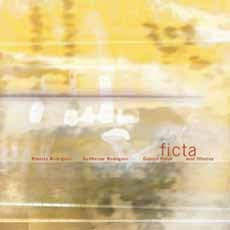
ficta
Ernesto Rodrigues | Guilherme Rodrigues | Gabriel Paiuk | José Oliveira | cs005
Zen Nihilism
It was through the baroque that improvisation was introduced in our (European, Occidental) art music. Coming from where? Perhaps from popular music, if we bear in mind that during the Middle Ages it was hardly possible to differentiate the music of the jesters from the one that was played and sung in the palaces - the real musical “division of classes" was then made with sacred music, which was property of the clergy. All the rest was simply profane. Now, improvisation, a profane musical activity by excellence, became one of the main characteristics of the baroque period. From the appearance of the basso continuum in the 17th century it was improvisation that was in charge of the properly so called baroque ornamentations. The "basso acompagnato" was used by the organ and harpsichord players to develop the harmonic aspects in the accompaniment of the voice or soloist instruments. Attempts were made so that the improvisational inventivity would not interfere with the central melodic line, but the recourse resulted in virtuosistic exibitions which, centuries later, would have their top projection on the ostentation displays of the rock electric guitar solos (mainly in heavy metal), and on the tenor and alto saxophones solos in jazz (particularly in the free faction). These two trends of the music in our days have more affinities with Bach and Handel than we are prepared to admit.
According to running chronicles, Bach added rapid passages and trills to the Vivaldi scores and placed in his own pages signals which were intentionally ambiguous, so that no one else could interpret them in the same way he would do it. The tradition remained: it is also known that Hummel embellished Mozart's piano concertos and that Liszt adapted Beethoven's sonatas. Mozart and Beethoven themselves were notable in the use of cadenzas, precisely to exercise their natural gifts as improvisers. The tocatas of Girolamo Frescobaldi were partially improvised, and Froberger was known by his long "intermezzi", reserved to the skillfulness and spontaneity of the interpreter. «Ficta», the name of the CD which joins the Portuguese Ernesto Rodrigues, Guilherme Rodrigues and José Oliveira with the Argentine pianist Gabriel Paiuk, used to be the name that was given, until the Renaissance, to the portion of a music work left to the discretion of the performer. The choice of this term for a title reminds us of the past of improvisation, defines the scope on which it is situated (the one of "cultured" music) and tells us that the part has covered the whole, meaning that the only music we will be able to listen here is the "ficta", the imaginary music which is impossible to determine on paper.
And nevertheless... with its spaces, the rarefaction of sounds and notes and the reduced volume maintained almost without alterations, everything in this music differentiates it from the baroque. The improvisation of «Ficta» relinquishes its baroque nature and seeks different paths other than those subordinated to the expression and the communication of emotivity, within the line defined by the bass player, theoretician and critic Peter Niklas Wilson and practiced by the new generation of improvisers who adhered to the "esthetics of silence". This ending is not at all unexpected to those who, like Paul DeMarinis, noticed that the "basso" of Alberti - such as, after all, the "drones" of the tamboura in Indian music and the repetitions in classical music - was nothing but a figuration of silence. In a lecture which took place in Palo Alto, U.S.A. this composer stated that even the inclusion of noise in today's music has a character similar "to the 'sfumato' described by Da Vinci in his painting treatise - a mist, a smoke spread over the most far-off zones to increase the perception of a space which separates them from what is in the foreground".
And if in «Sudden Music», recorded by Ernesto Rodrigues with José Oliveira and António Chaparreiro, everything seems to burst forth from silence, in this new CD it is to the opposed process that we are assisting: each initiated sound construction immediately remits itself to silence, goes back to it, dissolves, searches its matrix and its end in nothingness (though obviously a fictitious nothingness). Nihilism? Perhaps, but a Zen nihilism in which the destruction is only a moment of the creative flux.
Rui Eduardo Paes - (journalist and music writer)